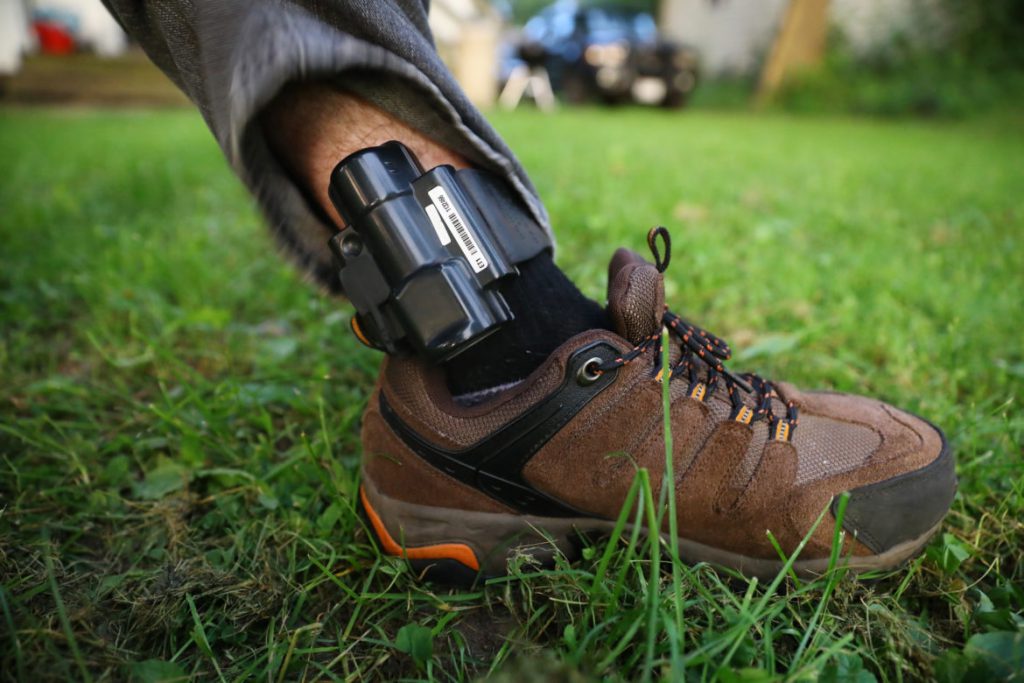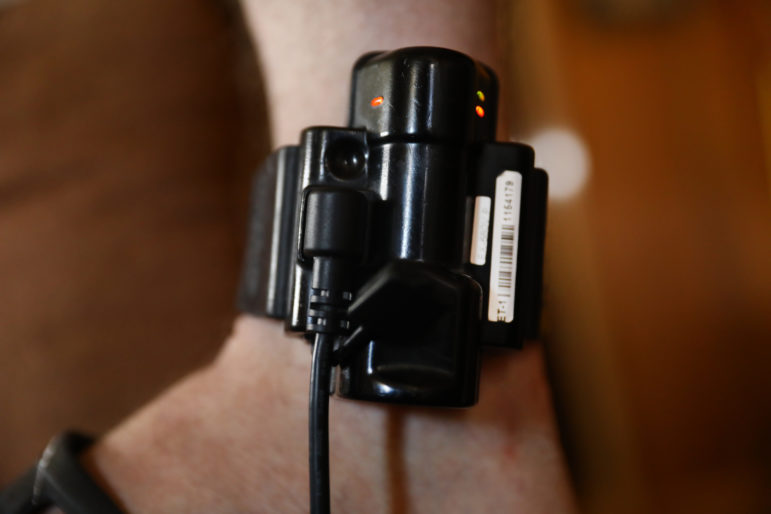State GPS Monitoring Has Huge Problems
Malfunctions, unnecessary jailings plague growing offender monitoring program.

Cody McCormick, 29, is pictured outside his rental apartment in Sparta, Wis., on Aug. 1, 2017. McCormick and his fiancé Breanna Kerssen had been living in the basement of his grandmother’s rural home but moved into town to alleviate continuous difficulties with the GPS monitoring device he must wear because of a sex-related conviction. The Wisconsin Center for Investigative Journalism found such problems are widespread. For example, state Department of Corrections records show most offenders on monitoring across the state experienced loss of satellite signal in May, generating 32,766 alerts that month — half of which were serious enough to be investigated. Photo by Coburn Dukehart/Wisconsin Center for Investigative Journalism.
Cody McCormick spent much of the past seven years incarcerated or on probation after being convicted of fourth-degree criminal sexual conduct in Minnesota.
Since he had his supervision transferred to his home state of Wisconsin in late 2016, McCormick has been repeatedly thrown in jail. He lost a job. And he continues to be disturbed by corrections officials calling him — sometimes in the middle of the night.
McCormick says these barriers to reintegrating into the community stem from a GPS ankle bracelet, which he was not required to wear in Minnesota but is required by Wisconsin to wear for life. As of January, Wisconsin monitored 1,258 offenders on GPS devices at an annual cost of about $9.7 million.
Such problems have led some law enforcement and other officials to doubt the program’s ability to ensure public safety and assist offenders in reintegrating into their communities.
Since the Center’s 2013 report, the cost of the program and the number of offenders under monitoring have roughly doubled. Lawmakers never followed through on calls to study the system in the wake of the Center’s report. State officials have been unable to produce records of any evaluation of the system’s reliability or effectiveness.
In this current report, the Center found numerous service requests and complaints related to bracelets failing to hold a charge. In February, a bipartisan group of lawmakers introduced a bill that would make it a felony for anyone on GPS monitoring to intentionally fail to charge his or her bracelet.
The state is drawing up a new request for bids for GPS monitoring equipment. Lawmakers are considering extending the length of the contract from three years to seven to entice additional bidders. Bill sponsor Rep. Ed Brooks, R-Reedsburg, said the current vendor, Boulder, Colorado-based BI Inc., is planning a 50 percent price hike unless the contract is lengthened.
Offender: Problems from the start
McCormick, 29, said his troubles with GPS monitoring began soon after being fitted with an ankle bracelet in February 2017. Records show the BI Inc. tracker was not communicating with the Department of Corrections’ Electronic Monitoring Center in Madison because of poor cellular reception at his grandmother’s house where he lived in rural Monroe County.
And even though police found him exactly where he was supposed to be, McCormick was taken to jail for about three days. As a result, he lost his job at his family’s restaurant.
Ten months later, McCormick was incarcerated again, this time for five days. Records from the Sparta Police Department show the arrest stemmed from McCormick allegedly being located next to a library — a zone off-limits for him — for an hour. McCormick said he only drove past it; his roommate, who was driving with him, affirmed this version of the incident.
McCormick’s difficulties persisted. This January, McCormick was briefly jailed on a warrant for allegedly tampering with the bracelet. A police report said McCormick showed them he had not tampered with it. He was later fitted with a new bracelet. Officials did not charge him with a crime — although tampering is a felony offense.
“It’s not just the people who are on monitoring devices (who are affected),” McCormick said. “It’s their family, their jobs, their social life.”

Cody McCormick, 29, packs belongings into his fiancé Breanna Kerssen’s car in rural Monroe County on Aug. 1, as they prepare to move from his grandmother’s house to an apartment in Sparta, Wis. McCormick faces ongoing difficulties with the GPS monitoring device he wears because of a conviction for a sex offense. Due to poor cell phone service at his grandmother’s house, the GPS device would lose contact with the Madison-based monitoring center, resulting in false alerts. Photo by Coburn Dukehart / Wisconsin Center for Investigative Journalism.
McCormick’s story illustrates broader flaws with Wisconsin’s GPS monitoring program, which relies on both cell phone and satellite service to track offenders.
The Center reviewed data from a single month, May 2017, to more deeply explore the large volume of alerts being triggered by Wisconsin’s monitored offenders. In all, Wisconsin offenders in May generated more than 260,000 GPS alerts, 81,000 of which corrections officials sorted through manually.
The review found:
- The state monitoring center lost cell connection 56,853 times with 895 offenders — or an average of about 64 times per offender, according to DOC records.
- Most offenders on monitoring across the state experienced loss of satellite signal, generating 32,766 alerts — half of which were serious enough to be investigated.
- Of the 52 arrest warrants issued by the DOC monitoring center, service request records indicate 13 involved offenders whose equipment was having technical problems around the same time.
- DOC employees submitted 135 requests for technical problems with GPS tracking devices— 93 for charging or battery issues with ankle bracelets, 12 for signals lost, 14 for false tamper alerts.
Other records showed:
- Several offenders have been jailed between one and three times since 2013 for what DOC records indicated or they reported were technical malfunctions.
- Since January 2015, DOC has filed 1,360 reports when offenders damaged, lost or absconded with DOC-issued equipment, including GPS equipment, sobriety monitors and home-confinement monitoring. An examination of a portion of those reports found at least 89 offenders had evaded GPS monitoring for some length of time, subverting the program’s goal of enhancing public safety.
- Some offenders claim their GPS shows them to be in places they are not or that they are arrested for tamper alerts when their devices’ ankle straps wear out.
Wisconsin’s problems not unique
A 2017 examination by the University College London and Australian National University of 33 studies on electronic monitoring effectiveness worldwide found one of the most frequent barriers to success was technological problems, including equipment malfunction, loss of signal or power, battery failure and inadequate broadband capacity.
In 2012, California replaced half of the state’s ankle bracelets after testing showed that brand, 3M, was so inaccurate and unreliable that its use put the public “in imminent danger.” In 2013, a Los Angeles County audit found one in four of its bracelets had defective batteries or excessive false alerts.

Cody McCormick, 29, shows the GPS monitoring device he is required to wear as a result of a sex-related conviction while living in Minnesota. He says the device has severely impacted his life, banging up his ankle, prohibiting him from wearing shorts or swimming, tearing holes in multiple pairs of pants and is socially embarrassing. Photo by Coburn Dukehart / Wisconsin Center for Investigative Journalism.
Massachusetts replaced all 3,000 of its GPS bracelets in 2016, citing poor cell coverage. A 2015 investigation by Northeastern University journalism students in Boston had found wrongful arrests caused by GPS false alerts.
Wisconsin DOC officials said the benefits of the program outweigh any technical drawbacks. Spokesman Tristan Cook noted that the program is aimed at public safety.
“GPS tracking provides a deterrent effect since offenders know they are being tracked and allows the department to review an offender’s location history to aid the prosecution of any crimes or identify supervision violations,” Cook said.
BI Inc., which supplies the ankle bracelets and other monitoring equipment, declined to answer questions about reported problems with the technology.
Ranks of monitored offenders swells
Technology does continue to improve, however, and states are aggressively increasing the number of offenders on GPS.
According to the Pew Charitable Trusts, 88,000 offenders were strapped with GPS bracelets in 2015 — 30 times more than the 2,900 offenders who were tracked a decade earlier. Wisconsin had a daily average of about 1,500 offenders on tracking in 2017-18 — a nearly 10-fold increase from 158 offenders in 2008-09.
Some experts say GPS monitoring can be a useful tool in providing structure, reducing recidivism, allowing offenders to work and lowering costs compared to incarceration. But technological problems can get in the way of those benefits.

Cecelia Klingele, an associate law professor at the University of Wisconsin-Madison, studies sentencing and correctional policy. She argues that even short periods of jail time are disruptive, and that the state Department of Corrections should investigate alleged GPS violations without incarceration, if possible, unless an offender poses an immediate risk to the public. Photo courtesy of the University of Wisconsin Law School.
Mike Nellis, editor of the Journal of Offender Monitoring, believes that GPS monitoring in the United States has taken on a punitive approach that hampers offender reintegration. The journal focuses on monitoring technology and its use in enhancing public safety.
“If (offenders) are trying to reintegrate themselves … to suddenly find yourself carted back to prison for something that is in no way your fault seems to me to be quite an unnecessary disruption in the life of an offender — and quite at odds with good practice in reintegrating them,” Nellis said.
DOC has the authority to detain offenders on monitoring for up to three work days while it investigates violations, although extensions may be granted.
Cecelia Klingele, a University of Wisconsin-Madison associate law professor who specializes in correctional policy, said DOC is put in a difficult position when it knows some, or even many, of the alerts it receives are caused by equipment malfunctions. But she argues the agency should investigate such alerts with minimal harm to the offender, especially in the case of false alerts.
“Even short periods of jail are highly disruptive and can cause a person to lose his job, be unable to care for children, or even lose stable housing,” Klingele said.
Local officials uncertain over GPS
Some officials in law enforcement and the judiciary who deal with Wisconsin’s GPS program have seen false alerts firsthand and have reservations about the program.
“It’s wilderness up here,” Price County Sheriff Brian Schmidt said of his county in northern Wisconsin. “When you’re dealing with that, you’re dealing with cell coverage issues. DOC needs to recognize those things. County taxpayers pay for these issues.”
Schmidt recalled an incident in which he refused to detain a GPS-monitored offender with a warrant because it appeared to stem from a device malfunction.
“If there’s a violation, I understand, but if … you find a gentleman in bed, and the monitor is failing, even though I have the (apprehension) request, I’m less likely to put that person in jail,” Schmidt said.
DOC sees it another way. “There is no such thing as a ‘false alert,’” Cook said. “If the monitoring center is not able to successfully resolve an alert, an offender is taken into custody to protect the public and comply with state statutes requiring continuous tracking.”

Steven Nichols, 48, is seen in his apartment in Whitehall, Wis. Nichols is a registered sex offender, having spent time in prison for two separate child sex-related convictions in 2005 and 2008. He is currently on supervision and has been placed on lifetime GPS monitoring. Nichols says the restrictions of supervision make it difficult to find a job. Photo by Coburn Dukehart / Wisconsin Center for Investigative Journalism.
Judge James Morrison of Marinette County, a sprawling, heavily forested county on the Michigan border, said concern about the reach of GPS tracking in rural areas was one factor that led him to reject the placement of a sex offender in July.
“It’s just common sense that we’re not getting a tremendous amount of protection out of this system,” Morrison said.
Nellis said when states conflate GPS monitoring with public safety, they are “giving the public quite excessive expectations at what GPS is capable of.”
Research shows that at least two-thirds of sexual assaults are perpetrated by individuals known to the victim — family members or acquaintances — not by strangers who might visit common GPS exclusion zones such as schools, day-care centers or parks.
Given the sprawling size of Marinette County — 1,400 square miles — and the three to four officers on hand to patrol it, responding to GPS apprehension requests would take too long to be effective, the judge said.
“(If) somebody cuts off their GPS monitor and decides they’re going to go bash in the skull of a witness in a case against them, what kind of protection do we get?” Morrison questioned. “They’ve (the monitoring center) got to tell our cops. Our cops are 70 miles away.”
Such is the case in records obtained by the Center. They show it can take days or even weeks for DOC or the police to locate errant offenders, especially if they are homeless or have removed their bracelets.
Other states, weighed down by excessive alerts, have seen tracked offenders commit serious crimes when officials delay in responding to alerts. In one case in Colorado, officials took five days to respond to a tamper alert from a paroled white supremacist, who had killed two people, including the then-head of the state’s Department of Corrections.

Steven Nichols says the GPS monitor he wears often fails, and he has been arrested and placed in jail repeatedly due to alleged GPS violations. To charge the unit Nichols, 48, must be tethered to a power outlet. Photo by Coburn Dukehart / Wisconsin Center for Investigative Journalism.
In Germany, an offender on electronic monitoring fled the country to join ISIS. A Kenosha offender removed his GPS bracelet and was found by police knocking on the door of his victim.
The Wisconsin Department of Corrections cannot always determine remotely whether alerts signify a technical issue or legitimate violation; they sometimes jail offenders while they investigate the alleged violation.
For instance, in May, DOC received 14 alerts for strap tampers — a felony in Wisconsin and seen as one of the most severe violations — that ended up being false alarms after no evidence of tampering was found upon inspection, a review of DOC records showed.
On the other hand, offenders can commit serious crimes without generating any alerts at all.
In July 2016, for instance, four offenders, three on electronic monitoring, allegedly sexually assaulted a 17-year-old girl at a halfway house near Madison. The crime was not detected because the three monitored offenders were right where they were supposed to be.
‘Tail wagging the dog’
Spurred by the high-profile kidnapping, rape and murder of a 9-year-old girl in 2005, Florida began requiring lifetime GPS monitoring of certain sex offenders, and California, Wisconsin and other states followed.
But evidence is mixed on whether it prevents new sex crimes.

Susan Turner, a professor of criminology at the University of California-Irvine, has studied the cost and effectiveness of the GPS monitoring program in California. “Although knowing the whereabouts of sex offenders is important,” she says, “the cost of monitoring sex offenders on GPS may outweigh these benefits.” Photo courtesy of the University of California-Irvine.
Recent studies show that electronic monitoring combined with traditional parole methods and treatment could lower rates of arrests, convictions and returns to custody. But a University College London study speculates that any positive effects may be due to increased compliance with treatment programs, not the monitoring itself.
Other studies show that even if GPS does produce some benefits, it may not be worth the cost.
Susan Turner, a professor of criminology, law and society at University of California-Irvine, has studied California’s GPS monitoring program. Turner argues such systems do not provide much benefit for the cost.
In a 2015 study on California’s GPS program that she co-authored, Turner found the system does reduce recidivism, but only for administrative violations such as failure to register as a sex offender, not for criminal sex and assault violations, where recidivism is already “very low.”
“I think they (lawmakers) had the tail wagging the dog,” Turner said. “They hadn’t really thought through what exactly they hoped to accomplish by putting it on, other than just saying we got the GPS on the sex offender.”
In her paper, Turner concluded that “although knowing the whereabouts of sex offenders is important, the cost of monitoring sex offenders on GPS may outweigh these benefits.”
In another Turner study from 2012, she found California’s program cost $4,600 per year more per high-risk sex offender than for those not on GPS because it takes more agents to keep up with the constant monitoring.
Technical malfunctions lead to jailings
About 96 full-time equivalent staff work at the DOC’s electronic monitoring center in Madison to investigate GPS alerts, notify agents or law enforcement of violations and pursue arrest warrants when necessary.
Warrants are issued when an offender allegedly removes his ankle bracelet or otherwise absconds from supervision, misses curfew or spends too long in an “exclusion zone” such as a park or school.
Offenders interviewed by the Center say they generally have experienced fewer malfunctions as time passes. Jessa Nicholson Goetz, a Madison-based criminal defense attorney, said that technological improvements have largely resolved the malfunctions her clients experienced. Still, problems do remain.

James Morgan is pictured with his wife Rachel and daughter Angela at his residence in Monona, Wis. Morgan, who spent 26 years in prison for sexual assault and other crimes, now wears a GPS ankle bracelet for life. He has been arrested several times due to GPS problems, most recently on July 4, 2017. Photo by Coburn Dukehart / Wisconsin Center for Investigative Journalism.
James Morgan, a sex offender profiled in the Center’s original report who was jailed for alleged GPS violations at least eight times between 2011 and March 2013, has been arrested three times since then for alleged GPS violations. DOC records show that one time was for a lost signal, which was not Morgan’s fault. In another case, Morgan said, his bracelet malfunctioned.
If found guilty of violating the terms of his monitoring, Morgan, 58, could be returned to prison for years. That prospect keeps him up at night.
“I could potentially never walk out,” Morgan said as his daughter, Angela, and new wife, Rachel, listened beside him. He thinks about that every time he is arrested, Morgan said.
“He’s not going to be the same when he comes back,” Angela chimed in. “Even if it’s for 48 hours. How do you give me my father back — but not really?”

James Morgan, who spent 26 years in prison for sexual assault and other crimes, now wears a GPS ankle bracelet for life. He has been arrested several times due to GPS problems, most recently on July 4, 2017. Despite these challenges, Morgan is still moving forward with his life. He married his longtime girlfriend Rachel at Madison’s First Unitarian Society on Aug. 26. Photo by Riley Vetterkind / Wisconsin Center for Investigative Journalism.
Aaron Hicks, who was featured in the Center’s 2013 GPS story, racked up at least 12 separate jail bookings between January 2011 and November 2012. Since then, he spent three days in jail for one violation — his ankle bracelet generated a tamper alert. But the DOC later found the violation unsubstantiated after it failed to find any evidence of tampering.
George Drake, president of Correct Tech LLC, an Albuquerque-based corrections technology consulting company, said agencies should find ways to reduce jailings by using more discretion.
“If I take this guy into custody, for this two-minute curfew violation, it’s going cost (the offender) his job, and he won’t be able to pay the victim his restitution, and it’s going to create an awful lot of hardships,” Drake said.
For corrections departments, however, creating more tolerant policies comes with risk. In New York, where officials set up a program to notify them only if an alert lasted for more than five minutes, an offender evaded monitoring and raped a 10-year-old girl and killed her mother in 2013.
GPS coverage poor in rural areas
The system’s ability to accurately locate offenders in rural areas, where cell service is poor, also can be spotty.
Several offenders told the Center they have received repeated phone calls from the monitoring center or their probation agents asking them to regain a signal or informing them they are located in places where offenders claim not to be.
David Bay, a sex offender on GPS from Ashland County, has been arrested three times on probation violations since 2013. He claimed the problem was with his monitoring bracelet. Bay said he is afraid to stray too far from the beacon at his home.
“My signal is so weak I spend very little time outside because if they lose me, they just come and get me. I’m in there two to three days for what? For nothing,” the 69-year-old Bay said on the phone from his home in Glidden.
Another offender from Sawyer County, who asked that his name not be used, was arrested in January 2017 after he said his battery malfunctioned. He lost a day of work.
“I’m an outdoor person. I have to be really careful about places where I go and things that I do,” the offender said. “There’s a lot of places that I want to go hunt and fish, and I can’t go see them because they don’t have cell phone signal.”

Steven Nichols, 48, is seen in his apartment in Whitehall, Wis. Nichols is a registered sex offender, having spent time in prison for two separate child sex-related convictions in 2005 and 2008. He is currently on supervision and has been placed on lifetime GPS monitoring. Nichols says the restrictions of supervision make it difficult to find a job. Photo by Coburn Dukehart / Wisconsin Center for Investigative Journalism.
Battery malfunctions are widely reported, according to DOC records. Of the 93 service requests submitted in May for battery problems, some were for batteries that failed to take a charge or drained within a few hours. BI Inc., the device manufacturer, advertises that its devices can hold a charge for up to 80 hours.
When GPS bracelets lose their charge prematurely, offenders who are outside of their homes must race to find a place to gain a charge, or face jail time.
“When they go dead, they go dead fast,” said Steven Nichols, 48, of Whitehall. “You’ll notice the battery gets hot and burns my leg and takes two hours to charge. … I once charged it fully and drove to Eau Claire (a 50-minute drive), and it was beeping that the battery was dead.”
Offenders say new devices take around 30 minutes to charge. But Jason Wolford, a 37-year-old offender on lifetime GPS and off of probation, said he has spent up to five hours sitting in one place to charge an older unit. GPS service requests show reports of charging taking up to seven hours.
Drake said the DOC could easily prevent bad batteries if it replaced them around the 300-day mark, since batteries approach the end of their life at around one year. Cook said DOC submits service requests when any potential technical issue is identified with equipment.
“They wait until the battery goes dead, and then they send it in for repairs, and that’s poor management,” Drake said. “You should be a little bit more proactive.”

Steven Nichols, 48, shows off a model tank he built in his apartment in Whitehall, Wis. The model depicts a WWII-era German tank. Because he has few places to go during the day, he has taken up model building as a hobby. He says the GPS unit he wears is uncomfortable, causing abrasions to his leg and makes it hard to wear footwear, including winter boots. Photo by Coburn Dukehart / Wisconsin Center for Investigative Journalism.
DOC declined to discuss its policy for changing device batteries.
After the Center’s 2013 report on troubles with Wisconsin’s GPS program, lawmakers requested a study on the reliability of the technology, but it never happened.
Former state Rep. Joan Ballweg, R-Markesan, who co-chaired the Joint Legislative Council in 2013, told the Center that the study died for lack of interest, failing to gain support among 90 suggested studies that session.
“There wasn’t somebody who was strongly committed to leading that particular topic,” Ballweg said, adding that there were other studies that “would be of more value for the Legislature at that particular time.”
A life still interrupted
On an early August evening with the summer sun setting behind them, McCormick, his fiance Breanna Kerssen and a friend hauled up from his grandmother’s basement boxes of clothes, an oscillating fan and a used canvas that Breanna hoped to paint over someday.
They carefully placed everything into two aging Acura sedans and drove down a winding country road to an apartment in Sparta where McCormick hoped better cellular reception would give him a life less interrupted by the corrections system.

Cody McCormick, 29, moves possessions into his rental apartment in Sparta, Wis., on Aug. 1, with the help of his friend Travis Ray, and fiancé Breanna Kerssen. While living in rural Monroe County, McCormick says the GPS monitor he wears repeatedly lost contact with the Department of Corrections’ monitoring center, resulting in false alerts, arrest warrants and jailings. Photo by Coburn Dukehart / Wisconsin Center for Investigative Journalism.
The apartment, a shabby second-floor walk-up, was only four miles from his grandmother’s. For McCormick, it might as well have been 4,000 miles.
“I was tired about getting phone calls (from the monitoring center),” McCormick said as he surveyed his new yard. “Here, I don’t have to worry about that as much.”
McCormick’s optimism, it turns out, was misplaced.
In addition to two more arrests since moving to Sparta, the monitoring center called McCormick in October when he came within half a block of a liquor store, which is one of his exclusion zones. Another time, he had to return home early from helping with his grandmother’s fall yard cleanup.
The monitoring center said it could not gain a signal.
The nonprofit Wisconsin Center for Investigative Journalism (www.WisconsinWatch.org) collaborates with Wisconsin Public Radio, Wisconsin Public Television, other news media and the UW-Madison School of Journalism and Mass Communication. All works created, published, posted or disseminated by the Center do not necessarily reflect the views or opinions of UW-Madison or any of its affiliates.
Losing Track
-
GPS Monitoring Inventor Says it’s Misused
 Mar 13th, 2018 by Riley Vetterkind
Mar 13th, 2018 by Riley Vetterkind
-
Many On GPS Monitoring Are Homeless
 Mar 10th, 2018 by Riley Vetterkind
Mar 10th, 2018 by Riley Vetterkind
-
Does GPS Monitoring Violate Civil Rights?
 Mar 8th, 2018 by Riley Vetterkind
Mar 8th, 2018 by Riley Vetterkind






















” As of January, Wisconsin monitored 1,258 offenders on GPS devices at an annual cost of about $9.7 million.” is $7,760 for each offender. And for that they get defective monitors? call me conservative right now, but for the harm it is causing, this is pure waste! How much good have they to claim for the monitoring? Is it safer than Minn., where 5they dont use GPS?
or should we reread the lines:
“Research shows that at least two-thirds of sexual assaults are perpetrated by individuals known to the victim — family members or acquaintances — not by strangers who might visit common GPS exclusion zones such as schools, day-care centers or parks.”
as well as the articles long sad litany of FUBAR?
Seeing the statistics raises serious questions on just what the state is trying to accomplish. Almost seems as if they are in it for the money. After doing a little research on the Minnesota aspect, they use gps on the offenders they feel need it, and also place it on those that are released for a few months or on those that violate terms of probation. The fact that the one guy received burns while charging is concerning as it could endanger others. The man from Minnesota has his conviction via no contest when he was 20, charged when 19. With no criminal convictions since then (public record). This shows me he has been doing well, meaning therapy is better or that he is remorseful of his actions.
We taxpayers seem to be paying for both malfunctioning devices and for them being locked up because of the malfunctions, and I for one do not care to see my money thrown away like that.
Perhaps the system needs a reboot, change how they use it and who they use it on, and get better devices that don’t break down. Ones that are more reliable, don’t rely fully on cell service and that aren’t as apt to damage skin/clothes
Forgot to add this part. Perhaps they should focus on therapy, and not use bracelets on those that have done good. Lifetime gps seems like auch a waste for those that don’t have violent records. Punishing those that have served out their incarcerations/supervision is a bit much